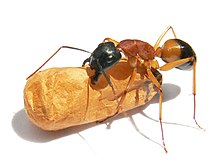| Banded sugar ant | |
|---|---|

| |
| Worker with cocoon | |
| Scientific classification | |
| Domain: | Eukaryota |
| Kingdom: | Animalia |
| Phylum: | Arthropoda |
| Class: | Insecta |
| Order: | Hymenoptera |
| Family: | Formicidae |
| Subfamily: | Formicinae |
| Genus: | Camponotus |
| Subgenus: | Tanaemyrmex |
| Species: | C. consobrinus
|
| Binomial name | |
| Camponotus consobrinus (Erichson, 1842)
| |

| |
| Distribution of the banded sugar ant | |
| Synonyms[1][2] | |
| |
The banded sugar ant (Camponotus consobrinus), also known as the sugar ant, is a species of ant native to Australia. A member of the genus Camponotus in the subfamily Formicinae, it was described by German entomologist Wilhelm Ferdinand Erichson in 1842. Its common name refers to the ant's liking for sugar and sweet food, as well as the distinctive orange-brown band that wraps around its gaster.
The ant is polymorphic and relatively large, with two different castes of workers: major workers (also known as soldiers), and minor workers. These two group of workers measure around 5 to 15 millimetres (0.2 to 0.6 in) in length, while the queen ants are even larger. Mainly nocturnal, banded sugar ants prefer a mesic habitat, and are commonly found in forests and woodlands. They also occur in urban areas, where they are considered a household pest. The ant's diet includes sweet secretions that are retrieved from aphids and other insects that it tends. This species is a competitor of the meat ant (Iridomyrmex purpureus), and food robbery and nest-plugging is known to occur between these two ants. Workers prey on insects, killing them with a spray of formic acid. Banded sugar ants are preyed upon by other ants, echidnas, and birds. The eggs of this species were consumed by Indigenous Australians.
- ^ Johnson, Norman F. (19 December 2007). "Camponotus consobrinus (Erichson)". Hymenoptera Name Server version 1.5. Columbus, Ohio, USA: Ohio State University. Archived from the original on 2 April 2015. Retrieved 1 April 2015.
- ^ Forel, Auguste H. (1902). "Fourmis nouvelles d'Australie" (PDF). Revue suisse de Zoologie. 10: 405–548. doi:10.5281/ZENODO.14495.